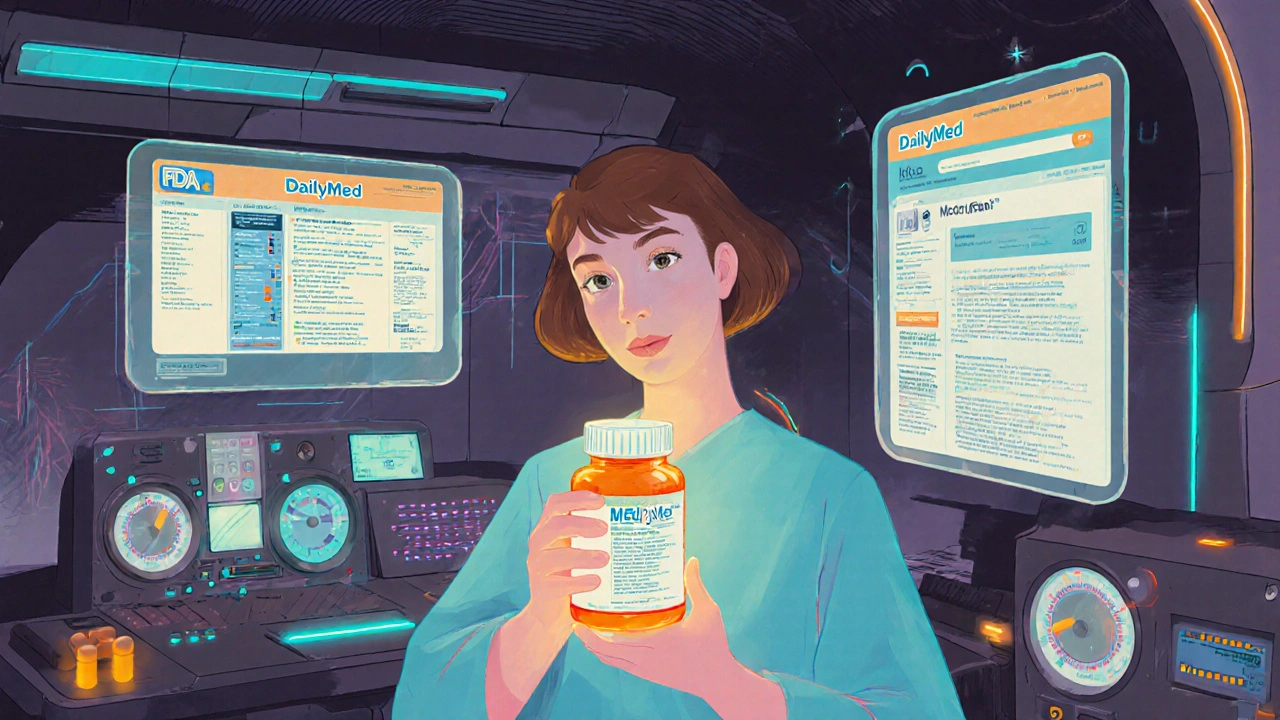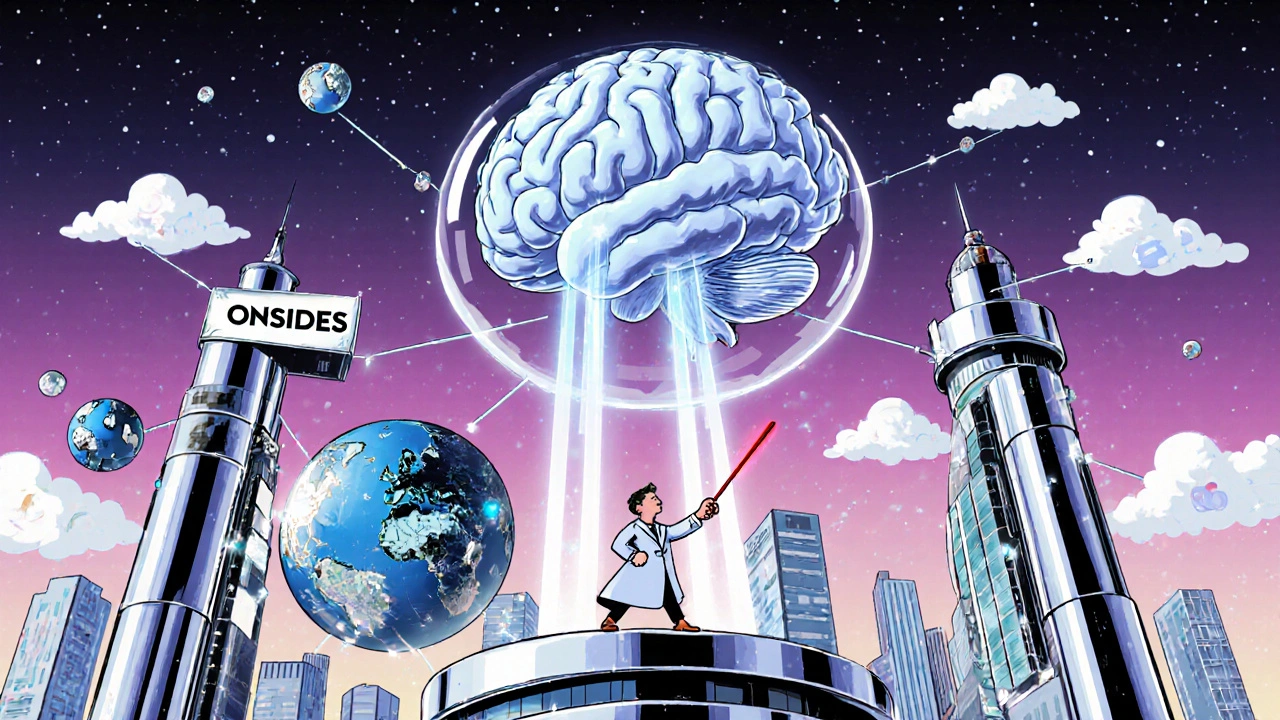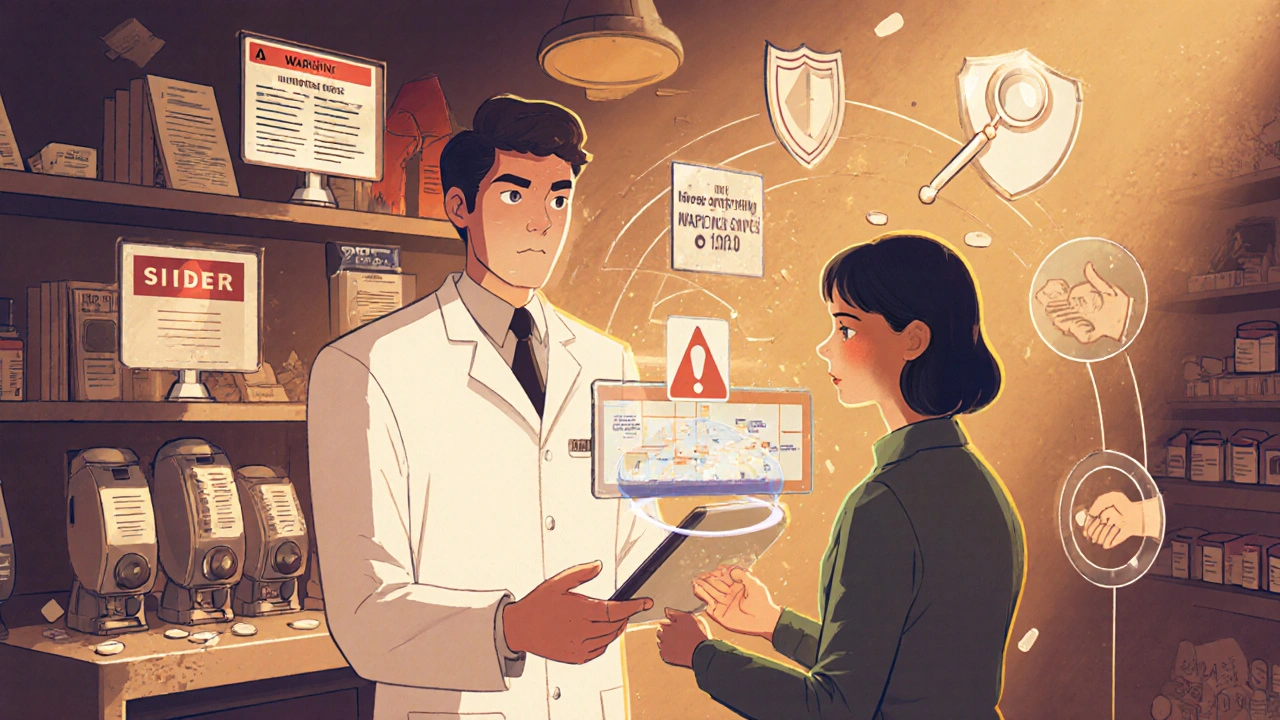Where to Find Detailed Side Effect Information for Your Medications

Medication Side Effect Checker
Find Reliable Side Effect Information
Search for your medication to see detailed side effect information from authoritative sources like FDA, DailyMed, and VigiAccess.
Side Effect Information
How this works
Based on your search, we've compiled information from multiple authoritative sources:
- DailyMed: Official FDA label with detailed adverse reactions
- OnSIDES: Real-world side effect data beyond clinical trials
- VigiAccess: Global reports of side effects from millions of cases
No results found
Try searching for a different medication name or check if you've spelled it correctly. Some medications have multiple names (brand/generic).
Knowing what side effects a medication might cause isn’t just helpful-it’s essential. Millions of people take prescription and over-the-counter drugs every day, but many don’t know where to find reliable, detailed information about what to expect. You might read the pamphlet that comes with your pill bottle, but that’s often simplified, missing rare reactions, or doesn’t explain how common they really are. So where do you go when you need real, detailed, up-to-date side effect data?
Start with the FDA’s FDALabel Database
The most authoritative source for side effect information is the FDA’s FDALabel database. This is where drug manufacturers legally submit the official labeling for every prescription and over-the-counter medication approved in the U.S. It’s not a summary. It’s the full, detailed document used by doctors and pharmacists. You’ll find everything: common side effects, rare but serious reactions, warnings, contraindications, and even data from clinical trials.
To use it, go to the FDA’s website and search for your drug by name. Once you find the label, skip to section 6: Adverse Reactions. That’s where the side effects are listed in order of frequency-common, uncommon, rare. You’ll also see if the reaction was reported in placebo groups (to help you tell what’s actually caused by the drug). For OTC meds, check the Warnings section instead.
Important: This data comes from clinical trials and early post-market reports. It doesn’t include every possible side effect that’s ever happened to someone-only those observed during testing or reported early enough to make the label. That’s why you need more sources.
Use DailyMed for Easy Access to FDA Labels
FDALabel can be hard to navigate. That’s where DailyMed comes in. It’s run by the National Library of Medicine and pulls all FDA-approved drug labels directly from FDALabel, then formats them cleanly for public use. You don’t need to dig through PDFs or jargon-heavy text. DailyMed breaks down each section clearly, highlights key warnings, and even includes the date the label was last updated.
It’s free, no login needed, and updated daily as new labels are approved. If you’re a patient or caregiver, DailyMed is your best starting point. Just search the drug name, click on the most recent version, and scroll to 6. Adverse Reactions. You’ll get the same official data, but in a layout that’s actually readable.
Check MedlinePlus for Plain-Language Explanations
Not everyone wants to read a medical document. That’s where MedlinePlus shines. Run by the National Library of Medicine, it translates FDA label data into everyday language. You’ll still get the full list of side effects, but they’re grouped by likelihood and explained simply. For example, instead of saying “dizziness (5.2%)”, it might say, “About 1 in 20 people feel dizzy when taking this drug.”
A 2023 survey of 2,891 users found that 87% found MedlinePlus easier to understand than FDA labels. It also links to related conditions, drug interactions, and what to do if you experience a side effect. If you’re overwhelmed by medical jargon, start here. Then go to DailyMed if you want the full technical details.

Look Beyond the Label: OnSIDES for Off-Label and Real-World Effects
Here’s something most people don’t realize: the side effects listed on your drug label only tell part of the story. Many reactions happen after the drug is already on the market-especially when taken with other medications, in older adults, or over long periods. That’s where OnSIDES comes in.
Launched in 2023, OnSIDES is a massive database built by analyzing over 46,000 FDA drug labels using advanced AI. It doesn’t just list what’s on the label-it uncovers side effects that were missed in clinical trials. For example, while a label might list 69 side effects, OnSIDES found an average of 329 high-confidence side effects per drug, including many that only show up when combined with other meds.
It’s not for casual browsing. OnSIDES is mostly used by researchers and clinicians, but the public can access the data through nSIDES.io. If you’re on multiple medications or have complex health issues, searching OnSIDES can reveal risks your doctor might not have mentioned. It’s updated quarterly, so it’s one of the most current sources available.
Use VigiAccess for Global Real-World Reports
What happens when millions of people take a drug over years? Side effects emerge that never showed up in trials. That’s what VigiAccess tracks. Run by the World Health Organization, it pulls data from over 35 million individual case reports submitted by doctors and patients worldwide.
Here’s how it works: if 287 people reported nausea after taking Drug X, VigiAccess will show you that number. It won’t tell you if that’s high or low compared to other drugs-but it can signal something unusual. For example, if a drug has 10 times more reports of a rare heart rhythm issue than similar drugs, that’s a red flag.
It’s free and easy to use. Type in your drug name, and you’ll see a list of side effects with how many times they’ve been reported globally. The catch? You can’t tell if the reaction was serious, or if it happened because of another condition. But it’s a powerful tool for spotting patterns you won’t find anywhere else.

Avoid Outdated or Paid Sources
Not all databases are created equal. SIDER, once popular among researchers, hasn’t been updated since 2015. Its website even says: “The data in SIDER is from 2015 and therefore out of date!” Using it now is like relying on a 2015 weather forecast. Don’t waste your time.
Another option you might see is PDR.net. It’s been around since the 1940s and used to be the go-to for doctors. But today, it’s a paid service ($50/year) and has been criticized for favoring drug manufacturers’ content. Many pharmacists avoid it because it doesn’t always include the latest safety updates.
Stick with free, publicly funded sources like DailyMed, MedlinePlus, OnSIDES, and VigiAccess. They’re updated regularly, transparent, and built for public use-not profit.
How to Use These Tools Together
Here’s a simple step-by-step approach:
- Start with MedlinePlus to get a clear, simple list of common side effects.
- Go to DailyMed to read the full FDA label-especially section 6.
- If you’re on multiple drugs or have chronic conditions, search OnSIDES for hidden interactions or off-label risks.
- Use VigiAccess to see if other people around the world have reported unusual reactions.
- Bring all this info to your doctor or pharmacist. Ask: “Are any of these side effects something I should watch for based on my other meds or health conditions?”
Don’t rely on one source. No single database has the full picture. The FDA label tells you what’s known at approval. OnSIDES shows you what’s been found since. VigiAccess shows you what’s happening in the real world. Together, they give you a complete safety profile.
What’s Changing in 2025 and Beyond
The FDA is requiring all drug labels to be in standardized digital formats by 2026. That means in the near future, your electronic health record might automatically warn you about side effects when a new prescription is added. AI tools like OnSIDES are getting better at predicting risks based on your age, other medications, and genetics.
But for now, the best tool you have is knowledge. Knowing where to look-and how to combine sources-gives you real power over your health. Side effects aren’t just listed on a bottle. They’re hidden in databases, global reports, and AI analyses. You don’t need to be a scientist to use them. You just need to know where to find them.
Can I trust side effect information from drug company websites?
No. Drug company websites often highlight benefits and downplay risks. They’re required to list side effects, but they may bury them in fine print or use vague language. Always cross-check with FDA sources like DailyMed or MedlinePlus, which are independent and legally required to be accurate.
Why do some side effects not appear on my prescription label?
Labels are based on data from clinical trials and early post-market reports. Many side effects only show up after thousands or millions of people have used the drug over years-especially rare ones, long-term effects, or reactions caused by combining drugs. That’s why databases like OnSIDES and VigiAccess are important-they track what happens after approval.
Is VigiAccess useful for common side effects like headaches or nausea?
Not really. VigiAccess is best for spotting unusual or rare reactions that aren’t well documented. Common side effects like headaches are reported everywhere and aren’t helpful to track. Use it when you’re concerned about something unusual-like a sudden skin rash, heart palpitations, or mood changes that aren’t listed on your label.
How often are drug labels updated with new side effect information?
Drug manufacturers must update labels within 15 days of learning about a new serious side effect. The FDA reviews and approves these updates. DailyMed reflects these changes the same day they’re approved. So if a new warning is issued, you’ll see it on DailyMed within 24 hours.
Should I stop taking my medication if I find a scary side effect online?
No. Many side effects listed are rare or unlikely for you. Stopping a medication suddenly can be dangerous. Always talk to your doctor first. Use the information to ask informed questions: “How common is this? Does it apply to me? What should I watch for?”

Anthony Griek
October 31, 2025 AT 08:14Been using DailyMed for years and never looked back. Found a rare interaction between my blood pressure med and a supplement I didn't even know was a problem. Took me 3 minutes to find it. No ads, no paywall, just straight facts.
Thanks for the reminder that the FDA actually has public tools. Most people don't even know they exist.
Norman Rexford
October 31, 2025 AT 18:42OnSIDES is the real MVP here. I looked up my antidepressant and found like 15 side effects not on the label. One was 'sudden urge to yell at strangers' - turns out I've been having that for months. My doc laughed but took it seriously. Also PDR.net is trash, don't waste your money.
Also why is everyone still using SIDER? That thing's older than my first iPhone.
Wayne Keller
November 2, 2025 AT 14:17Good breakdown. I teach health literacy at the community center and I use MedlinePlus all the time. It's perfect for older folks who get overwhelmed by medical jargon.
Just last week, a lady came in scared because her pill bottle said 'dizziness' and she thought she was going to pass out every time she stood up. We checked MedlinePlus - turns out it's 8% of people and usually goes away after a week. She felt so much better.
Always start simple, then go deeper if you need to.
Shana Labed
November 3, 2025 AT 09:24OMG YES I LOVE ONSIDES!!! I found out my migraine med could cause hallucinations in like 0.3% of people and I had one last year and thought I was losing my mind!!
Also VigiAccess is wild - I searched for my birth control and saw 47 reports of sudden hair loss from people in Brazil and Nigeria!! I never would've thought that was linked!!
Also why is anyone still using PDR?? It's like using a fax machine in 2025 😭
California Daughter
November 3, 2025 AT 13:05...I'm not sure I trust any of these... I mean, who even runs these sites? The government? What if they're hiding stuff? I read on a blog that the FDA gets funding from Big Pharma... so... maybe they're just putting out the 'safe' version? ...Just saying...
Also, I think side effects are just the body's way of telling you you're not in alignment with your true energy...
Maybe try crystals? Or a cleanse? I did a lemon water detox and my anxiety disappeared...
Also, why are all these sites in English? What about non-English speakers? ...Just a thought...
Vishwajeet Gade
November 3, 2025 AT 20:17USA has best health data. India has no access to this. We use Google translate on FDA labels. No one here knows about DailyMed. My cousin died from side effect no one warned about. Why no Hindi version? Why no free app? Why only rich people get safety info? This is injustice.
Also OnSIDES? Sounds like American startup. Not for poor countries.
Stop bragging. Help us.
Casey Crowell
November 4, 2025 AT 03:21Just used VigiAccess to check my cholesterol med and saw 200+ reports of muscle pain in people over 65 - my dad’s on it. I showed my mom and she cried. We called his doctor and they switched him. Saved his mobility.
Also OnSIDES is like a superhero database. I’m obsessed. I’ve been digging into every med my family takes now. It’s wild how many hidden risks there are.
Also, why isn’t this on TikTok? This info should be everywhere. 🚀💊
Shanna Talley
November 5, 2025 AT 10:28This is exactly the kind of info we need to share more. So many people panic because they don’t understand what’s normal vs. rare. I always tell my friends: don’t Google symptoms, Google the drug name + FDA label. It changes everything.
Also, if you’re on multiple meds, OnSIDES is your new best friend. I’ve saved two people from dangerous combos just by checking it.
Knowledge isn’t power - it’s peace of mind.
Samuel Wood
November 5, 2025 AT 12:55...I suppose these sources are adequate, though I must say, the reliance on publicly funded databases is rather... quaint. One might argue that the real goldmine lies in proprietary pharmacovigilance platforms like Advera or MedAware - which, admittedly, are not free, but they employ proprietary NLP models trained on billions of EHR records...
...and frankly, DailyMed's interface is still a relic of the early 2000s. Have you seen the metadata schema? It's archaic.
...I suppose it's better than nothing, though.
ridar aeen
November 6, 2025 AT 02:10OnSIDES is brilliant. But why does it only cover US-approved drugs? What about the 80% of the world that doesn't use FDA labels? Why is this still so American-centric?
Also, I tried VigiAccess and found a side effect I’ve had for years - and it’s only been reported 12 times globally. That’s not rare. That’s systemic neglect.
These tools are great, but they’re not justice.
chantall meyer
November 7, 2025 AT 06:27Interesting. I suppose this is the kind of thing Americans do - obsess over data. In South Africa, we just take what the pharmacist says and hope for the best. But I suppose if you have the time and the internet, why not?
Still, I find it odd that you trust databases more than your doctor. Isn’t that what they’re trained for?
...though, I did check OnSIDES for my diabetes med. Found three side effects my doctor didn’t mention. Huh.